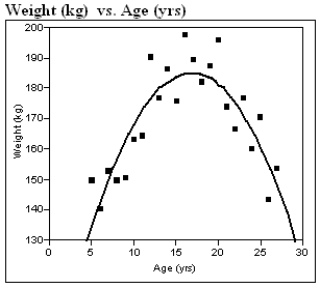Polar bear cubs are born in the winter in dens, and they must live off the fat stores of the mother even after leaving the den for sea ice, since the availability of their prey is unpredictable. Therefore, maternal weight is an important factor in successful reproduction of polar bears. In a recent spring, 261 adult females with 492 cubs were captured as they left their dens, and the mothers' weight and ages were determined by "counting annuli in the cementum of an extracted vestigial premolar tooth." (We are NOT making this up!) A quadratic fit of the maternal weight in kilograms to age in years resulted in the regression analysis below.  Polynomial Fit Degree=2
Polynomial Fit Degree=2
Weight = 82.920 + 12.134 Age − 0.360(Age )^2 

a)On average, about how far off are the weights of the maternal bears? That is, what is a typical difference between the actual weights and the weights predicted by the quadratic model?
b)If the maternal weight is an important factor as discussed above, what age of the female would seem to be the best for reproduction success? In a few sentences, justify your answer by appealing to the information provided above.
Correct Answer:
Verified
b)The ...
View Answer
Unlock this answer now
Get Access to more Verified Answers free of charge
Q30: Assessing the goodness of fit of a
Q44: Exhibit 4-4:
Biological theory suggests that the relationship
Q45: A common statistical method for estimating a
Q46: Exhibit 4-2
The theory of fiber strength suggests
Q48: Assessing the goodness of fit of a
Q50: Exhibit 4-2
The theory of fiber strength suggests
Q51: Exhibit 4-6
During the first 3 centuries AD,
Q52: Suppose that the locally minted coins analyzed
Q53: Exhibit 4-7
Golden-rumped elephant shrews have long flexible
Q54: One of the problems when estimating the
Unlock this Answer For Free Now!
View this answer and more for free by performing one of the following actions

Scan the QR code to install the App and get 2 free unlocks

Unlock quizzes for free by uploading documents